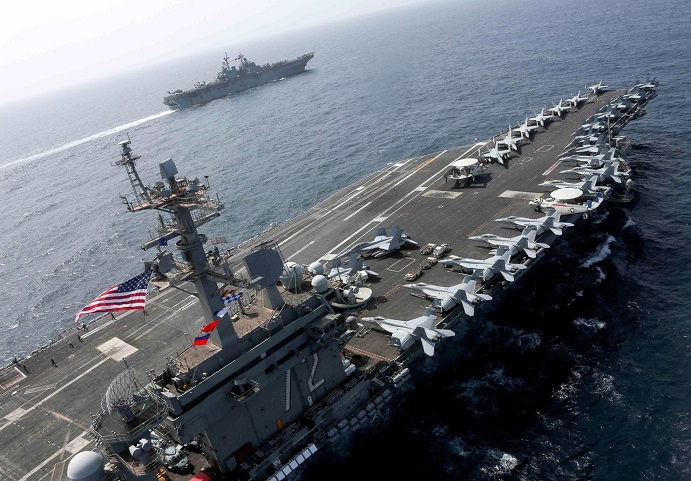White House bullying and sanctions have succeeded in uniting an otherwise divided Iranian public behind the government.
The Nation / July 11, 2019
On Sunday, July 7, Iran declared that it was beginning to enrich uranium above the limit specified by the multilateral nuclear deal it signed in 2015 in exchange for US sanctions relief. It was the second statement Iran had made in as many weeks to alert the international community that it was breaching the requirements of what President Trump repeatedly described as the “worst possible deal” and which the United States had pulled out of the previous year. Iran’s first announcement made clear that it was exceeding the agreed stockpile level of the lowest grade of enriched uranium—a claim quickly confirmed by the International Atomic Energy Agency. In both cases, Iran gave weeks of warning, appealing to European leaders to deflect the new US sanctions currently strangling its economy. Tehran claimed it could reverse the decision easily and was taking these steps to save the 2015 deal (formally known as the Joint Comprehensive Plan of Action, or JCPOA).
Iran’s carefully constructed choreography in the face of economic asphyxiation at home and a US military build-up on its borders has so far been a study in strategically considered policy decisions, delivered in the measured language of international relations. What’s more, Tehran has not simply stayed within the constraints of the deal but has lived up to its spirit as well. Indeed, the much-maligned nuclear deal has turned out to be a very flexible instrument, designed to accommodate signatories that are deeply suspicious of each other; paragraph 36, cited frequently by Iran, allows noncompliance to be met with remedial measures by any signatory state. This does not mean all will end well, or that Iran’s consistency will be recognized—or indeed, responded to in a constructive or coherent manner.
For a full year, since May 2018, when Washington declared it would no longer be party to the deal, Iran was the only signatory that remained in full compliance—with the possible exception of oil-rich Russia, which likewise is under US sanctions, and for the moment, peripheral to the action. (China has shilly-shallied, as it has sought to use its Iranian oil imports as a bargaining chip in its fraught trade negotiations with the United States; recently it upped those imports after a significant drop in May, a sign more of Beijing’s attempts to pressure Washington than of compliance with the terms of the JCPOA.) The European signatories (France, Britain, and Germany), unable to get around the American financial lock on Iran and thus guarantee that their companies could do business with Iran without suffering US retaliation, in effect re-imposed sanctions, rendering the Europeans noncompliant.
As the French oil giant Total and several of the European airlines, among a raft of other big companies, pulled out of Iran, Britain, France, and Germany attempted to establish a work-around financial mechanism called INSTEX, though it has not succeeded in providing financing beyond basic goods like food and medicine, which aren’t affected by the sanctions.
The Iranian leaders’ disinclination to be goaded by the United States and flounce out of the deal came as a surprise to decision-makers in Washington, who see Iran as an erratic and malevolent force. But from the outset, President Hassan Rouhani and Foreign Minister Javad Zarif, Iran’s designers of the JCPOA, had bet their careers on getting hard-line Supreme Leader Ali Khamenei to back the deal, and they were not going to let the United States stymie that achievement.
What is more, Tehran’s calculated decision to show itself as the responsible party internationally—unwavering in the face of US backtracking—gathered around its leaders the support of the Iranian public. For Iranians, the United States chose the wrong issue on which to attack their country. They had celebrated when President Rouhani signed the deal, anticipating the economic expansion that the end of sanctions would bring. The agreement in effect ushered in a “Tehran Spring,” as hope among the business community inspired a raft of new small ventures and a few large oil and gas deals with multinational companies. Iran’s full compliance was a source of pride inside the country, even as many Western firms, and most American ones, hesitated to do business with Iran due to restraints still in place within the US banking industry.
When President Trump reneged on the deal and re-imposed sanctions, the Iranian public felt betrayed; perhaps no single move from the outside could have united a variegated and otherwise divided population behind the government so effectively. The most recent announcement of Iran’s breach of the deal’s terms was carefully timed to play on this feeling. Heavy with symbolism, the press conference took place only a few days after the anniversary of the 1988 shooting down of an Iran Air passenger flight by a US guided missile cruiser, the Vincennes, during the Iran-Iraq War—an incident for which the United States has not apologized or made amends, and which prompted the leadership at the time to develop the discourse of “resilience,” which characterized much of Iran’s subsequent approach during the years of US sanctions and decades of political isolation. Today, both economic and political resilience are back. Though deeply divided ideologically, the two leadership nodes—the reformists, represented by President Rouhani, and the hard-liners, by Supreme Leader Khamenei—have been brought together by the new crisis.
This has translated into a coherent policy approach from Tehran, played out on two key stages. On the one hand are the carefully managed and well-publicized breaches designed to serve as signals to the Europeans that they need to recommit to the nuclear deal and jump-start negotiations to avoid an accidental war breaking out in the Gulf. The Europeans have clearly understood that these are not belligerent countermoves by an Iran intent on restarting full nuclear production.
Anxious to keep Iran in the deal, and critical of the US withdrawal, French President Emmanuel Macron has taken the lead, proposing to both Presidents Rouhani and Trump to establish a temporary freeze on sanctions in exchange for a roll-back of Iran’s enrichment, setting the stage for new negotiations.
On the other hand, as the US naval build-up took place, Iran also demonstrated that it has significant military capacity in the Gulf and is prepared to protect its sovereign borders. Although information is sparse regarding the exact nature of the recent attacks on oil tankers in the Gulf of Oman, or indeed, on the exact coordinates of the US drone when it was shot down by Iran’s Islamic Revolutionary Guard Corps, the message was consistent: Iran has options, and it will exercise them if pressed. As the rhetoric of blame surged, both sides made clear they did not want war.
What Iran likewise communicated during that tense week was that the ball was not entirely in the US court, and that Iran was not to be confused with North Korea. Trump’s offer of talks without preconditions, made while visiting Tokyo, was, the Iranians indicated, meaningless, as was sending his close ally and sanctions practitioner Shinzo Abe, Japan’s prime minister, to Tehran as an envoy. In moves consistent with their demands that any talks had first to show that Trump has skin in the game, they rebuffed Abe’s overtures. (One of the tankers that was attacked in the Gulf during his visit was Japanese. Just a coincidence?)
However, Iran’s pragmatic efforts to keep US naval forces at bay while prodding the Europeans to action may backfire, because of the incoherence at the heart of the Trump administration. On the one side is Trump’s own reluctance to go to war. On the other, the commitment to regime change by any means on the part of Secretary of State Mike Pompeo and National Security Adviser John Bolton. Buffeted back and forth between these two powerful and contradictory forces, US policy toward Iran has been inconsistent and often rash, resulting in both a policy and a naval buildup for which there are, at this point, no obvious off-ramps. For Iran, the issue now, as the outgoing UK ambassador to the United States Kim Darroch observed in his leaked e-mails, is how to help an adversary who is “inept” and “incompetent” find a way out, for the benefit of both Iran and the United States.
Roxane Farmanfarmaian teaches modern Middle East politics at the University of Cambridge and is the author of Blood and Oil: A Prince’s Memoir of Iran from the Shah to the Ayatollah.













